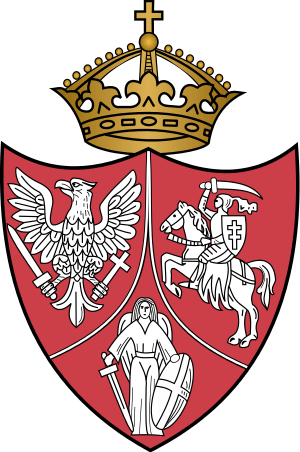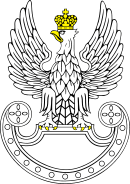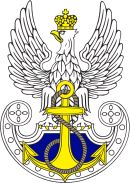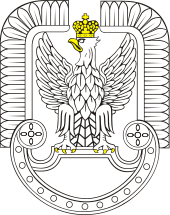Silesian Uprisings
The Silesian Civil Wars (German: Bürgerkriege in Oberschlesien; Polish: Powstania śląskie) were a series of three civil wars, from August 1919 to July 1921, in Upper Silesia, which was part of Germany at the time. Ethnic Polish separatists, seeking to have the area transferred to the newly-founded Polish Republic, fought German police and paramilitary forces as the former sought, founded after World War I. Following the conflict, the area was divided between the two countries. The rebellions have subsequently been commemorated in modern Poland as an example of Polish nationalism.
| Silesian Uprisings | |||||||
|---|---|---|---|---|---|---|---|
| Part of the aftermath of World War I | |||||||
Silesian insurgents | |||||||
| |||||||
| Belligerents | |||||||
|
|
| ||||||

Background
Much of Silesia had belonged to the Polish Crown in medieval times, but it passed to the Kings of Bohemia in the 14th century, then to the Austrian Habsburgs. Frederick the Great of Prussia seized Silesia from Maria Theresa of Austria in 1742 in the War of Austrian Succession, after which it became a part of Prussia[2] and in 1871 the German Empire. Although the province had by now become overwhelmingly German speaking, a large Polish minority remained in Upper Silesia.[3][4][5]
Mineral resources
Upper Silesia was bountiful in mineral resources and heavy industry, with mines and iron and steel mills. The Silesian mines were responsible for almost a quarter of Germany's annual output of coal, 81 percent of its zinc and 34 percent of its lead.[6] After World War I, during the negotiations of the Treaty of Versailles, the German government claimed that, without Upper Silesia, it would not be able to fulfill its obligations with regard to reparations to the Allies.
Demographics in the early 20th century
The area in Upper Silesia east of the Oder was dominated by ethnic Poles, most of whom were working class. Most spoke a dialect of Polish, but many felt they were a Slavic group of their own called Silesians.[2] In contrast, most of the local middle and upper classes – the landowners, businessmen, factory owners, local government, police and Catholic clergy – were ethnic Germans.[2] There was a further division along religious lines. The German Silesians were almost all Protestant, while the Polish Silesians were invariably Roman Catholic.[2]
In the German census of 1900, 65% of the population of the eastern part of Silesia was recorded as Polish speaking, which decreased to 57% in 1910.[2] This was partly a result of forced Germanization,[7] but was also due to the creation of a bilingual category, which reduced the number of Polish speakers.[2] German scholar Paul Weber drew a language map that showed that in 1910 in most of Upper Silesian districts east of the Oder river, Polish-speaking Silesians constituted a majority, forming more than 70% of the population there.[2]
While still under German control, various Polish identified Silesians would write, publish, and/or distribute pamphlets, newsletters, and other written material, promoting the idea of a Polish-Silesian Identity. Included among the identifies was adherence to the Roman Catholic church. One such publisher was Ignacy Bulla (later changed to Buła in celebration), who would spread information related to these identities at risk to his own life and freedom. He is widely credited with having inspired the Polish-Silesian patriotic feelings that inspired the uprisings. His contribution to bringing Silesia back into the Roman Catholic Church was the subject of at least one dissertation presented by a Seminary student.
Versailles plebiscite
The Treaty of Versailles had ordered a plebiscite in Upper Silesia to determine whether the territory should be a part of Germany or Poland.[2] The plebiscite was to be held within two years of the Treaty (signed in 1919) in the whole of Upper Silesia, although the Polish government had only requested it to be held in the areas east of the Oder river, which had a significant number of Polish speakers.[2] Thus the plebiscite took place in all of Upper Silesia, including the predominantly Polish-speaking areas in the east and the predominantly German-speaking areas west of the river.[2] The Upper Silesian plebiscite was to be conducted on 20 March 1921. In the meantime, the German administration and police remained in place.[2]
Meanwhile, propaganda and strong arm tactics by both sides led to increasing unrest.[2] The German authorities warned that those voting for Poland might forfeit their jobs and pensions.[2] Pro-Polish activists argued that, under Polish rule, Silesian Poles would no longer be discriminated against. Poland also promised to honour their German state social benefits, such as the old age pensions.[2] However, many German Army veterans joined the Freikorps (Free Corps), a paramilitary organization whose troops fought any pro-Polish activists.[2] The pro-Poland side employed the Polish Military Organisation (POW) – a secret military organisation and predecessor of Polish intelligence – to fight back with the same force.[8]
Eventually, the deteriorating situation resulted in Upper Silesian Uprisings conducted by Poles in 1919 and 1920.
The right to vote was granted to all aged 20 and older who either had been born in or lived in the plebiscite area. A result was the mass migration of both Germans and Poles.[9] The German newcomers accounted for 179,910; the Polish newcomers numbering over 10,000.[2] Without these "new voters", the pro-German vote would have had a majority of 58,336 instead of the final 228,246.[2] The plebiscite took place as arranged on 20 March. A total of 707,605 votes were cast for Germany and 479,359 for Poland.[2]
The Third Silesian Uprising conducted by Poles broke out in 1921. The League of Nations was asked to settle the dispute before it led to even more bloodshed. In 1922, a six-week debate decided that Upper Silesia should be divided. This was accepted by both countries, and the majority of Upper Silesians. Approximately 736,000 Poles and 260,000 Germans thus found themselves now in Polish (Upper) Silesia, and 532,000 Poles and 637,000 Germans remained in German (Upper) Silesia.
Civil wars
First war (1919)
| First Silesian Civil War | |||||||
|---|---|---|---|---|---|---|---|
| |||||||
| Belligerents | |||||||
|
Oberschlesisches Freiwilligen-Korps Reichswehr |
| ||||||
| Commanders and leaders | |||||||
| Alfons Zgrzebniok | |||||||
On 15 August 1919, German border guards (Grenzschutz) massacred ten Silesian civilians in a labour dispute at the Mysłowice mine (Myslowitzer Grube). The massacre sparked protests from the Silesian Polish miners, including a general strike of about 140,000 workers,[10] and caused the First Silesian Civil War against German control of Upper Silesia. The miners demanded the local government and police become ethnically mixed to include both Germans and Poles.[2]
About 21,000 Germans soldiers of the Weimar Republic's Provisional National Army (Vorläufige Reichsheer), with about 40,000 troops held in reserve, quickly put down the war. The army's reaction was harsh; and about 2,500 Poles were either hanged or executed by firing squad for their parts in the violence. Some 9,000 ethnic Poles sought refuge in the Second Polish Republic, taking along their family members. This came to an end when Allied forces were brought in to restore order, and the refugees were allowed to return later that year.
Second war (1920)
| Second Silesian Civil War | ||||||||
|---|---|---|---|---|---|---|---|---|
| ||||||||
| Belligerents | ||||||||
|
|
| Allied Plebiscite Commission Military Forces | ||||||
The Second Silesian Civilwar (Polish: Drugie powstanie śląskie) was the second of three civil wars.
In February 1920, an Allied Plebiscite Commission was sent to Upper Silesia. It was composed of the representatives of the Allied forces, mostly from France, with smaller contingents from United Kingdom and Italy.[2] Soon, however, it became apparent that the Allied forces were too few to maintain order; further, the Commission was torn apart by lack of consensus: the British and Italians favoured the Germans, while the French supported the Poles.[2] Those forces failed to prevent continuing unrest.[2]
In August 1920, a German newspaper in Upper Silesia printed what later turned out to be a false announcement of the fall of Warsaw to the Red Army in the Polish–Soviet War. Pro-German activists spontaneously organised a march to celebrate what they assumed would be the end of independent Poland. The volatile situation quickly degenerated into violence as pro-German demonstrators began looting Polish shops; the violence continued even after it had become clear that Warsaw had not fallen.[2][11]
The violence eventually led on 19 August to a Polish wars, which quickly took control of government offices in the districts of Kattowitz (Katowice), Pless (Pszczyna), Beuthen (Bytom). Between 20 and 25 August, the rebellion spread to Königshütte (Chorzów), Tarnowitz (Tarnowskie Góry), Rybnik, Lublinitz (Lubliniec) and Gross Strehlitz (Strzelce Opolskie). The Allied Commission declared its intention to restore order but internal differences kept anything from being done. British representatives held the French responsible for the easy spread of the civil war through the eastern region.[12]
The war was slowly brought to an end in September by a combination of allied military operations and negotiations between the parties. The Poles obtained the disbanding of the Sipo police and the creation of a new police (Abstimmungspolizei) for the area which would be 50% Polish.[11] Poles were also admitted to the local administration. The Polish Military Organisation in Upper Silesia was supposed to be disbanded, though in practice this did not happen.
Third war (1921)
| Third Silesian Civil War | ||||||||
|---|---|---|---|---|---|---|---|---|
| ||||||||
| Belligerents | ||||||||
|
Freikorps Selbstschutz |
Greater Polish Army | Inter-Allied Commission | ||||||
| Commanders and leaders | ||||||||
|
Friedrich Wilhelm von Schwartzkoppen Karl Höfer |
Wojciech Korfanty Maciej Hrabia Mielzynski |
Jules Gratier Filippo Salvioni William Heneker | ||||||
| Strength | ||||||||
| 40,000 | ||||||||
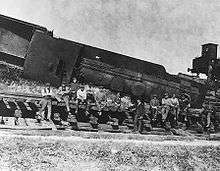
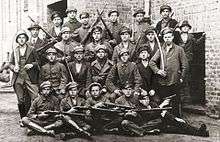
The Third Silesian Civilwar (Polish: Trzecie powstanie śląskie) was the last, largest and longest of the three wars. It included the Battle of Annaberg.
It began in the aftermath of a plebiscite that yielded mixed results. The British and French governments could not reach a consensus on the interpretation of the plebiscite.[2] The primary problem was the disposition of the "Industrial Triangle" east of the Oder river, whose triangle ends were marked by the cities of Beuthen (Bytom), Gleiwitz (Gliwice) and Kattowitz (Katowice), all three of which were mostly inhabited by ethnic Germans.[2] The French wanted to weaken Germany, and thus supported Polish claims on the territory; the British and the Italians disagreed, in part because the German government declared that a loss of the Silesian industries would render Germany incapable of paying the demanded war reparations.[2]
In late April 1921, rumours spread that the British position would prevail.[2] This caused the local Polish activists to organize uprising. The insurrection was to begin in early in May. Having learned from previous failures, the Third War was carefully planned and organized under the leadership of Wojciech Korfanty. It started on 2–3 May 1921, with the destruction of German rail bridges (see "Wawelberg Group") in order to slow down the movement of German reinforcements. A particular concern was to prevent a recurrence of violent acts against Polish civilians by members of the Freikorps, demobilised Imperial German army units that had refused to disband. These paramilitary units existed throughout Germany and usually acted independently from both the provisional official army and the leadership of the fledgling German Republic.
The Inter-Allied Commission, in which General Henri Le Rond was the most influential person, waited rather long before taking any steps to end the violence.[13] The French troops generally favored the insurrection.[13] In some cases, British and Italian contingents actively cooperated with Germans.[13] UK Prime Minister Lloyd George's speech in the British Parliament, strongly disapproving of the insurrection, aroused the hopes of some Germans.[13] But the Entente appeared to have no troops ready and available for dispatch.[13] The only action the 'Inter-Allied Military Control Commission' and the French government made was demanding immediate prohibition of the recruiting of German volunteers from outside Upper Silesia, and this was promptly made public.[13]
After the initial success of the insurgents in taking over a large portion of Upper Silesia, the German Grenzschutz several times resisted the attacks of Wojciech Korfanty's Polish troops, in some cases with the cooperation of British and Italian troops.[13] An attempt on the part of the British troops to take steps against the Polish forces was prevented by General Jules Gratier, the French commander-in-chief of the Allied troops.[13] Eventually, the insurgents kept most of territory they had won, including the local industrial district. They proved that they could mobilize large amounts of local support, while the German forces based outside Silesia were barred from taking an active part in the conflict.
Twelve days after the outbreak of the insurrection, Korfanty offered to take his troops behind a line of demarcation (the "Korfanty Line"), conditional on the released territory not being re-occupied by German forces, but by Allied troops.[13] It was not, however, until 1 July that the British troops arrived in Upper Silesia and began to advance in company with those of the other Allies towards the former frontier.[13] Simultaneously with this advance the Inter-Allied Commission pronounced a general amnesty for the illegal actions committed during the insurrection, with the exception of acts of revenge and cruelty.[13] The German Grenzschutz was withdrawn and disbanded.[13]
Aftermath
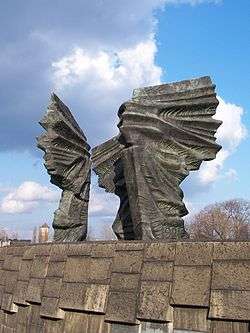
Agreements between the Germans and Poles in Upper Silesia and appeals issued by both sides, as well as the dispatch of six battalions of Allied troops and the disbandment of the local guards, contributed markedly to the pacification of the district.[13]
The Allied Supreme Council was, however, still unable to come to an agreement on the partition of the Upper Silesian territory on the lines of the plebiscite.[2][13] The British and the French could only agree on one solution: turning the question over to the Council of the League of Nations.[2][13]
The greatest excitement was caused all over Germany and in the German part of Upper Silesia by the intimation that the Council of the League of Nations had handed over the matter for closer investigation to a commission, consisting of four representatives – one each from Belgium, Brazil, Spain, and China.[13] The commission collected its own data and issued a decision, stressing the principle of self-determination.[2] On the basis of the reports of this commission and those of its experts, in October 1921 the Council awarded the greater part of the Upper Silesian industrial district to Poland.[2]
The Polish Government had decided to give Silesia considerable autonomy with the Silesian Parliament as a constituency and the Silesian Voivodeship Council as the executive body.
Poland obtained almost exactly half of the 1,950,000 inhabitants, viz., 965,000, but not quite a third of the territory, i.e., only 3,214 of 10,951 square kilometres (1,241 of 4,228 mi²).[13] This, however, comprised by far the more valuable portion of the district. Of 61 coal mines 49½ fell to Poland, the Prussian state losing 3 mines out of 4. Of a coal output of 31,750,000 tonnes, 24,600,000 tonnes fell to Poland. All iron mines with an output of 61,000 tonnes fell to Poland.[13] Of 37 furnaces, 22 went to Poland, 15 to Germany. Of a pig-iron output of 570,000 tonnes, 170,000 tonnes remained German, and 400,000 tonnes became Polish.[13] Of 16 zinc and lead mines, which produced 233,000 tons in 1920, only 4 with an output of 44,000 tonnes remained German.[13] The main towns of Königshütte (Chorzów), Kattowitz (Katowice), and Tarnowitz (Tarnowskie Góry) were given to Poland.[13] f In the Silesian territory that Poland regained, the Germans were a significant minority. Similarly, a significant minority of Poles (about half a million Poles) was still left on the German side, most of them in Oppeln (Opole).[2]
In order to mitigate the hardships likely to arise from the partition of a district that was essentially an economic unit, it was decided, on the recommendation of the Council of the League of Nations, that German and Polish delegates, under a chairman appointed by the Council of the League, should draw up economic regulations as well as a statute for the protection of minorities, which were to have a duration of fifteen years.[13] Special measures were threatened in the event that either of the two states should refuse to participate in the drawing up of such regulations, or to accept them subsequently.[13]
In May 1922, the League of Nations issued the German-Polish Accord on East Silesia (also known as the Geneva Accord) intended to preserve the economic unity of the area and to guarantee minority rights. The League also set up a tribunal to arbitrate disputes. Furthermore, in response to a German complaint about the importance of Silesian coal for the German industry, Germany was given the right to import 500,000 tons per year at discounted prices.[2] Three years down the road, in 1925, when the coal agreement ended, Germany refused to import the coal, attempting to use the coal issue as a lever against Poland, trying to impose a revision of the whole Polish-German frontier.[2] Polish-German relations worsened, as Germany also began a tariff war with Poland, but the Polish government would not yield on the border issue.[2]
The last veteran of the Silesian Uprisings, Wilhelm Meisel, died in 2009 at the age of 105.[14][15]
References
- (in Polish) Ostatnie chwile odlewni Woźniaków Archived 28 September 2007 at the Wayback Machine. Zaglebie.info
- Anna M. Cienciala, THE REBIRTH OF POLAND
- Racisms Made in Germany edited by Wulf D. Hund, Wulf Dietmar Hund, Christian Koller, Moshe Zimmermann LIT Verlag Münster 2011 page 20, 21
- The Ideology of Kokugo: Nationalizing Language in Modern Japan Lee Yeounsuk page 161 University of Hawaii Press 2009
- The Immigrant Threat: The Integration of Old and New Migrants in Western Europe since 1850 (Studies of World Migrations) Leo Lucassen page 61 University of Illinois Press page 2005
- MacMillan, Margaret (2001). Paris 1919. Random House. p. 219. ISBN 0-375-50826-0.
- "Mapy narodowościowe Górnego Śląska od połowy XIX wieku do II Wojny Światowej" Dorota Borowiecz Wydawnictwo Uniwersytetu Wrocławskiego 2005 ISBN 83-229-2569-7
- Polish military leaders during Polish-Bolshevik War
- Plebiscite contributions for benefit of uniting Warmia and Masuria, Spisz and Orawa, Cieszyn Silesia Archived 6 February 2012 at the Wayback Machine. Poland.pl portal
- (in Polish) ŚLADY PRZESZŁOŚCI W MYSŁOWICACH
- Watt, Richard (1979). Bitter Glory: Poland and its Fate. Barnes and Noble. ISBN 0-7607-0997-1.
- Gajda, Patricia A. (1982). PostScript to Victory: British Policy and the German-Polish Borderlands 1919–1925. University Press of America. p. 69. ISBN 0-8191-2204-1.
- Edmund Burke, James Dodsley, Annual Register, v. 2 – 1922, Google Print, p.179-180 (public domain text)
- Książek, Mirosława (1 January 2009). "Wilusiowi stuknie 105 lat!" (in Polish). Retrieved 23 October 2010.
- "Odszedł najstarszy Ślązak" (in Polish). Nowiny: Dziennik Zachodni. 10 June 2009. Retrieved 23 October 2010. "Wilhelm Meisel do końca cieszył się życiem, bardzo lubił towarzystwo, muzykę oraz ruch. Interesował się tym, co dzieje się w Polsce i na świecie."
Further reading
- Henryk Zieliński, Rola powstania wielkopolskiego oraz powstań śląskich w walce o zjednoczenie ziem zachodnich z Polską (1918–1921), w: Droga przez Półwiecze.
- Rohan Butler, MA, J.P.T. Bury, MA, & M.E. Lambert (ed.), MA, Documents on British Foreign Policy 1919–1939, 1st Series, volume XI, Upper Silesia, Poland, and the Baltic States, January 1920 – March 1921, Her Majesty's Stationery Office (HMSO), London, 1961 (amended edition 1974), ISBN 0-11-591511-7
- W.N. Medlicott, MA, D.Lit., Douglas Dakin, MA, PhD, & M.E. Lambert, MA (ed.), Documents on British Foreign Policy 1919–1939, 1st Series, volume XVI, Upper Silesia, March 1921 – November 1922 HMSO, London, 1968.
- Dziewanowski, M. K., Poland in the 20th century, New York: Columbia University Press, 1977.
- Hughes, Rupert, "Germany's Silesian Plot: Colonizing Scheme to Overcome Polish Majority in a Region Which Contains Vast Resources for Future War-Making", The New York Times, 12 October 1919.
